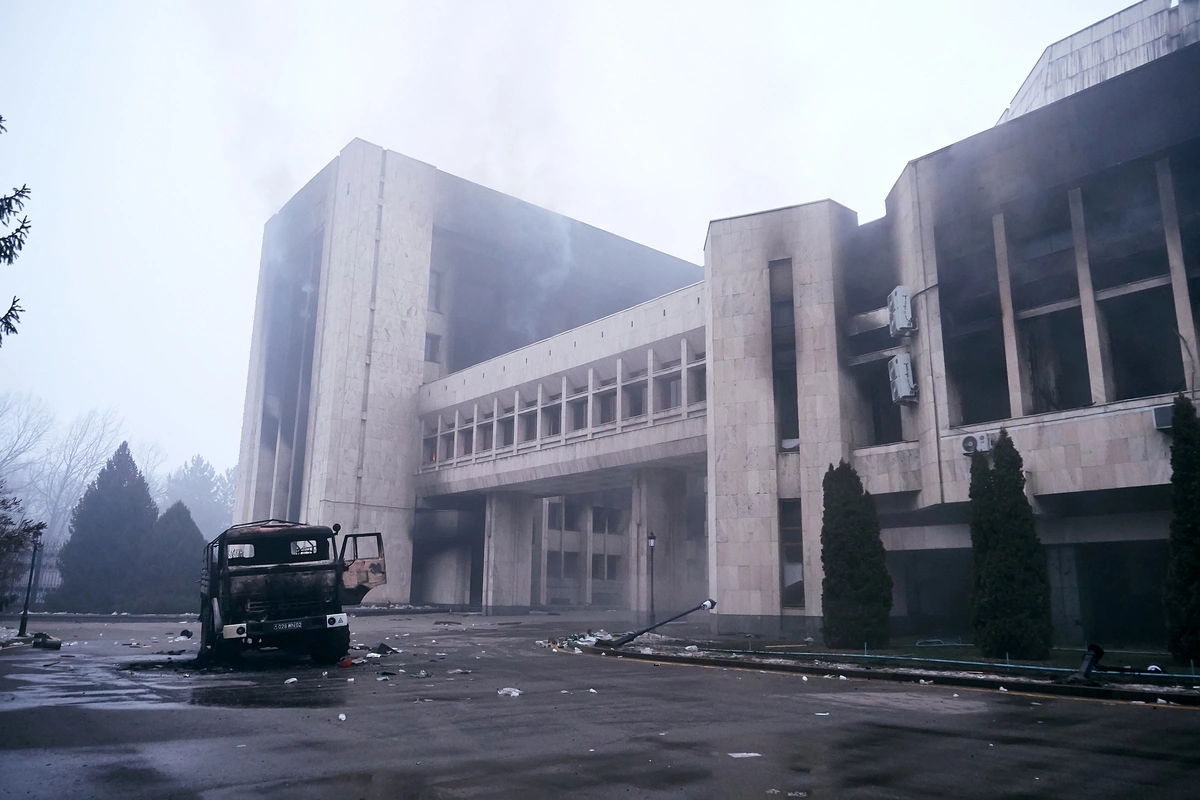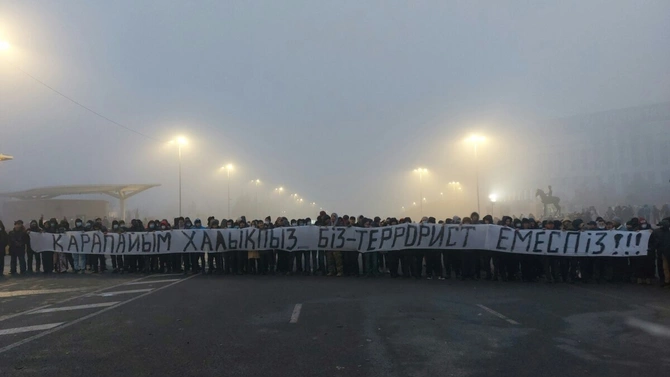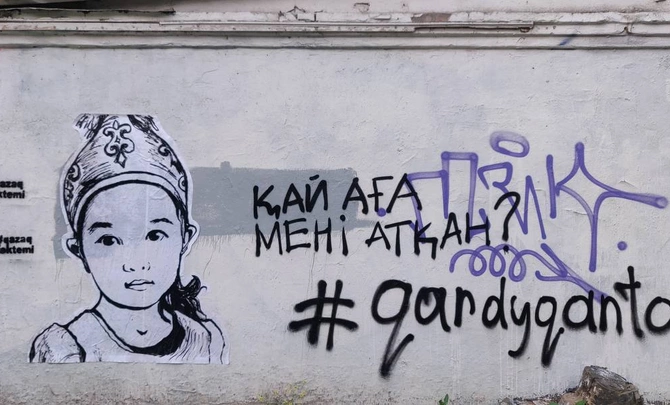
Remembering the bloodiest tragedy of independent Kazakhstan
Almaty’s main administrative building after the 6 January 2022 fire. Image: NICK MELNICHENKO/Shutterstock
Two years ago, an unprecedented event in Kazakhstan’s modern history, known as Qandy Qantar (Kazakh: Bloody January), became the biggest uprising the country has seen since gaining its independence. What started as a protest against the increased gas prices in Zhanaozen soon evolved into country-wide anti-government protests. The most aggressive riots soon took over the biggest city in Kazakhstan, Almaty, and descended into chaos with armed people looting shops, robbing banks, and firing at police and others.
Unable to stop the uprising that many feared would result in a civil war, President Tokayev asked The Collective Security Treaty Organization (CSTO), a collective military alliance of Russia, Belarus, Armenia, Kazakhstan, Kyrgyzstan, and Tajikistan, for help. That same day, CSTO troops started arriving in Kazakhstan, and the unrest was soon stopped. With 238 people dead and 10,000 arrested, the January 2022 protests became the bloodiest tragedy for the whole nation.
On 2 January, hundreds of people took to the streets in western Kazakhstan’s city of Zhanaozen, protesting the increased gas prices. The next day, there were over 3000 protesters, with people in Aktobe, Shymkent, Almaty, and Astana organizing their protests in solidarity with Zhanaozen residents. On 4 January, it was announced that the old gas price would be restored. However, that was no longer the only demand from the protesters.
On the night of 5 January, President Tokayev declared a state of emergency in the Mangistau Region and Almaty, and police started using tear gas, stun grenades, and rubber bullets against protesters at Republic Square in Almaty, Radio Azattyq reported. Republic Square in Almaty had not seen such violence since December 1989, when the Soviet police used force to suppress the uprising of young students, mostly ethnic Kazakhs, who opposed Gorbachev’s decision to replace Dinmukhamet Kunayev, the First Secretary of the Communist Party of Kazakhstan, with Gennadiy Kolbin, who besides being an ethnic Russian, never lived in Kazakhstan and was seen as an outsider by the locals.
Following protesters’ demands, the government resigned on the morning of 5 January. However, President Tokayev announced that he would not leave the country and took the chairmanship of the Security Council, which was assigned to former President Nazarbayev for life. Yet that didn’t change anything, as the protesters in Almaty

In response to the events of 5 January, the next day, Tokayev asked for military assistance from the CSTO, declaring that the country was under attack by ‘terrorists.’ In response to being called ‘terrorists,’ people who continued protesting for political change came out to the Republic Square in Almaty with a large banner in Kazakh saying, “We are ordinary people, we are not terrorists!!!” Meanwhile, the chaos was unfolding in Almaty as people were posting


Protesters at Republic Square in Almaty with the banner "We are ordinary people. We are not terrorists!!!" Photo: Aidana Zhanadilova
On 7 January, the constitutional order was restored, and the government building was under the control of law enforcement. On 13 January, CSTO troops started leaving Kazakhstan, despite the common fear that once they arrived, it would be hard to get rid of the Russian military in the country.
Even though Tokayev was able to stop the uprising with the help of CSTO troops, the switch in his narrative was signalling the changes to the public. Most notably, the Kazakhstani President started dismissing Nazarbayev’s family members from their positions. Among them were three of Nazarbayev’s sons-in-law—Kairat Sharipbayev, husband of Nazarbayev’s eldest daughter Dariga Nazarbayeva, left his post of chairman of the board of Qazaq Gaz, the national gas company of Kazakhstan; Dimash Dosanov, the husband of Nazarbayev’s youngest daughter Aliya, left his chairman position at KazTransOil, the national oil transporter in Kazakhstan; and finally Timur Kulibayev, husband of Nazarbayev’s middle daughter Dinara (the richest couple in Kazakhstan with a combined wealth of $6.2 billion, according to Forbes) resigned from his position as chairman of the presidium of the National Chamber of Entrepreneurs Atameken.
Another family member of the Nazarbayev clan ruling the country even after the head of the family’s retirement, Samat Abish, Nazarbayev’s nephew, was removed from his post as the First Deputy Chairman of the National Security Committee. Karim Masimov, Chairman of the National Security Committee, who previously had been the country’s Prime Minister, was less lucky, as besides losing his position, he was taken into custody on 8 January. In April 2023, Masimov was convicted for 18 years, unlike Abish, who remains free.
All of these resignations also pointed to the fact that the power was changing. Despite Tokayev coming to power in 2019, the public perceived him as a puppet of Nazarbayev. However, after Nazarbayev lost his status of ‘Leader of the Nation’ and the capital’s name was reverted from Nur Sultan to Astana, Tokayev promised reforms in ‘New Kazakhstan.’
Lastly, on 18 January, former President Nazarbayev

In the midst of it all were ordinary people. According to Kazakh authorities, 238 people died during those days of unrest. BBC Russian Service reported that by 13 January, the number of detained was over 10,000 across the country. The youngest victim, a four-year-old Aykorkem Meldekhan, was killed on 7 January, when the car in which she was with her father, brother, and sister came under fire on Republic Square. The bullet hit Aykorkem in the head. Only one law enforcement officer was accused of “exceeding authority,” and in November 2023, was acquitted by the military court in Almaty.

On the graffiti is Aykorkem Meldekhan. Translation of the graffiti: "Who shot me? #QandyQantar" Image: RUKH2K19D
Tokayev’s administration was unable to prove to its citizens the legitimacy of its claims of real political changes in the country following the January tragedy. Human Rights Watch reported in December 2022 that the government failed to investigate the human rights violations after the protests in January 2022. Those include torture, abuse of protesters, and bringing justice to the families of the deceased by prosecuting the law enforcement officers responsible.
Share on social media